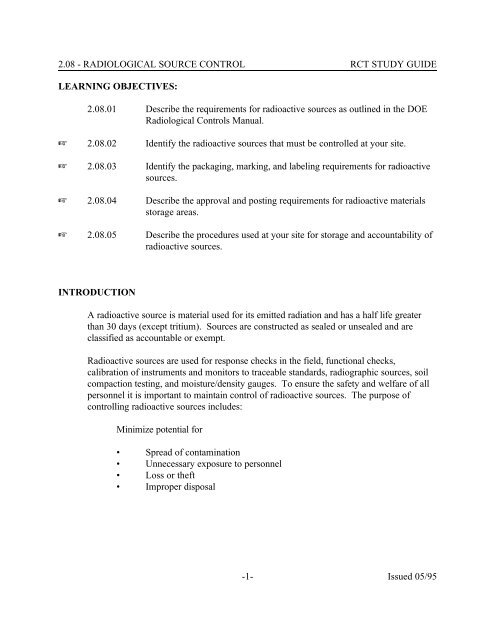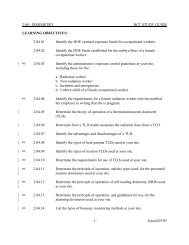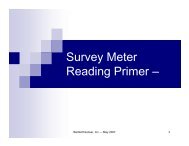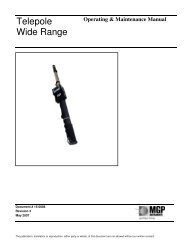2.08 - radiological source control - rct study guide - NukeWorker.com
2.08 - radiological source control - rct study guide - NukeWorker.com
2.08 - radiological source control - rct study guide - NukeWorker.com
Create successful ePaper yourself
Turn your PDF publications into a flip-book with our unique Google optimized e-Paper software.
<strong>2.08</strong> - RADIOLOGICAL SOURCE CONTROL RCT STUDY GUIDELEARNING OBJECTIVES:<strong>2.08</strong>.01 Describe the requirements for radioactive <strong>source</strong>s as outlined in the DOERadiological Controls Manual.<strong>2.08</strong>.02 Identify the radioactive <strong>source</strong>s that must be <strong>control</strong>led at your site.<strong>2.08</strong>.03 Identify the packaging, marking, and labeling requirements for radioactive<strong>source</strong>s.<strong>2.08</strong>.04 Describe the approval and posting requirements for radioactive materialsstorage areas.<strong>2.08</strong>.05 Describe the procedures used at your site for storage and accountability ofradioactive <strong>source</strong>s.INTRODUCTIONA radioactive <strong>source</strong> is material used for its emitted radiation and has a half life greaterthan 30 days (except tritium). Sources are constructed as sealed or unsealed and areclassified as accountable or exempt.Radioactive <strong>source</strong>s are used for response checks in the field, functional checks,calibration of instruments and monitors to traceable standards, radiographic <strong>source</strong>s, soil<strong>com</strong>paction testing, and moisture/density gauges. To ensure the safety and welfare of allpersonnel it is important to maintain <strong>control</strong> of radioactive <strong>source</strong>s. The purpose of<strong>control</strong>ling radioactive <strong>source</strong>s includes:Minimize potential for• Spread of contamination• Unnecessary exposure to personnel• Loss or theft• Improper disposal-1- Issued 05/95
<strong>2.08</strong> - RADIOLOGICAL SOURCE CONTROL RCT STUDY GUIDEDOE RADIOLOGICAL CONTROL MANUAL<strong>2.08</strong>.01 Describe the requirements for radioactive <strong>source</strong>s as outlined in the DOERadiological Controls Manual.In accordance with the DOE Radiological Control Manual, the following provisions applyto sealed and unsealed <strong>source</strong>s:• G-N 5400.9/M1 describes how sealed <strong>source</strong>s shall be <strong>control</strong>led and maintained,and specifies requirements for receipt, inventory, storage, transfer, disposal andintegrity testing. Unsealed <strong>source</strong>s shall be <strong>control</strong>led and maintained in a similarmanner except for integrity testing.• Procurement of radioactive <strong>source</strong>s shall be coordinated with the RadiologicalControl Organization.• Receipt surveys of <strong>radiological</strong> material shipments shall be performed by theRadiological Control Organization.• Radioactive <strong>source</strong>s, including radiography <strong>source</strong>s, shall not be brought on-site byexternal organizations without the prior written approval of the RadiologicalControl Organization.DOE G-N 5400.9/M1 IMPLEMENTATION GUIDE: SEALED RADIOACTIVESOURCE ACCOUNTABILITY AND CONTROLThis notice was issued in November 1994 and distributed with the series ofimplementation <strong>guide</strong>s for occupational radiation protection. The IG provides anacceptable methodology for establishing and operating a sealed radioactive <strong>source</strong>accountability and <strong>control</strong> program that will <strong>com</strong>ply with U.S. Department of Energyrequirements specified in DOE Notice N5400.9, Sealed Radioactive SourceAccountability. The IG clarifies the requirements of DOE Notice N 5400.9 and the RCM,and provides guidance for the structure, function, and operation of a sealed radioactive<strong>source</strong> accountability and <strong>control</strong> program.The IG establishes <strong>guide</strong>lines for custodians, training, receipt, inventory, labeling, storage,use, transfer, survey, test, disposal and records associated with <strong>source</strong>s.-2- Issued 05/95
<strong>2.08</strong> - RADIOLOGICAL SOURCE CONTROL RCT STUDY GUIDECONTROL OF SOURCES<strong>2.08</strong>.02 Identify the radioactive <strong>source</strong>s that must be <strong>control</strong>led at your site.(Insert site specific information here)Types of <strong>source</strong>s:• Accountable Sealed Radioactive Source - A sealed radioactive <strong>source</strong> with ahalf-life greater than or equal to 30 days and an activity greater than or equal tothose listed in Appendix B of the IG.• Exempted Radioactive Material - Radioactive materials exempted fromaccountability under DOE Notice N 5400.9, but subject to the requirements of 10CFR 835 and DOE Order 5480.11. Exempted radioactive materials include:materials in process, activated shielding materials, liquid and gaseous <strong>source</strong>s.Materials defined as consumer products (e.g., camera lenses, lantern mantles,smoke detectors, welding rods, etc.) are not subject to these requirements.• Exempted Sealed Radioactive Source - A sealed <strong>source</strong> having radioactivematerial with a half-life of less than 30 days or an activity less than the values forvarious radionuclides listed in Appendix B of the IG.• Sealed Radioactive Source - Radioactive material that is contained in a sealedcapsule, sealed between layers of nonradioactive material, or firmly fixed to anonradioactive surface by electroplating or other means. The confining barrierprevents dispersion of the radioactive material under normal and most accidentalconditions related to use of the radioactive <strong>source</strong>.Responsibilities:• The Radiological Control Organization shall maintain or delegate the responsibilityfor:(1) establishing the program (n5400.9 (6.a))-3- Issued 05/95
<strong>2.08</strong> - RADIOLOGICAL SOURCE CONTROL RCT STUDY GUIDE(2) maintaining records related to the accountability and <strong>control</strong> of accountablesealed radioactive <strong>source</strong>s for a facility (N5400.9 (7.a.1&2))(3) providing each <strong>source</strong> custodian with an inventory list of accountablesealed radioactive <strong>source</strong>s assigned to him or her (N5400.9 (7.a.1))(4) assisting the <strong>source</strong> custodian in training <strong>source</strong> users(N5400.9 (7.a.1))• The <strong>source</strong> custodian:(1) shall be responsible for ensuring that tests to establish the integrity of anaccountable sealed radioactive <strong>source</strong> are conducted (N5400.9 (7.b)) andinventory checks are performed at least every 6 months (N 5400.9 (7.b)).(2) should maintain records of the storage and use locations of all assignedaccountable sealed radioactive <strong>source</strong>s (N 5400.9 (7.a.2)).(3) shall be trained as a <strong>radiological</strong> worker prior to being designated as a<strong>source</strong> custodian.(4) shall notify and obtain approval of the RCO prior to:• any major changes in the use of a sealed radioactive <strong>source</strong>• on-site transfer of a sealed radioactive <strong>source</strong> to a new permanentstorage location• modification of a device containing a sealed radioactive <strong>source</strong>• disposal or off-site transfer of a sealed radioactive <strong>source</strong>• any procurement or acquisition of additional sealed radioactive<strong>source</strong>s(5) should also notify the RCO in the event of the loss or damage to anyaccountable sealed radioactive <strong>source</strong>• The <strong>source</strong> user:(1) should be an individual trained by the RCO and the <strong>source</strong> custodian to useeither accountable or exempt sealed radioactive <strong>source</strong>s-4- Issued 05/95
<strong>2.08</strong> - RADIOLOGICAL SOURCE CONTROL RCT STUDY GUIDE(2) should be trained as a <strong>radiological</strong> worker and receive appropriate trainingon handling their specific sealed radioactive <strong>source</strong>(s).General• Radioactive <strong>source</strong>s (solid, liquid, or gas) used exclusively for their emittedradiation and which retain their physical form and configuration during use shall besealed to prevent the leakage of any radioactive material. Sources such as alphaemitters and special research <strong>source</strong>s that cannot be covered during use shall havea separate container that encloses the <strong>source</strong> when not in use.Sources are <strong>control</strong>led using the following precautions:• Each <strong>source</strong> is to be inspected before each use.• Remove damaged <strong>source</strong>s from service.• Fingers, whether gloved or not, or other objects should never be allowed to touchthe active surface of unsealed <strong>source</strong>s.• Protect the <strong>source</strong> from being contaminated when used in a surface contaminationarea.RECEIPTPrior to receipt of accountable sealed radioactive <strong>source</strong>s, the RCO should assign the<strong>source</strong>s to the proper <strong>source</strong> custodians. Immediately upon receipt of accountable sealedradioactive <strong>source</strong>s, the RCO should be notified. The packaging should be inspected fordamage and a contamination and radiation survey performed. The RCO shall performreceipt surveys (RCM 431.3). A <strong>source</strong> integrity test shall be performed upon receipt ifvisible damage to the package exists (N 5400.9 (7.d)), or prior to initial use. The <strong>source</strong>custodian should be notified of the arrival of the sealed <strong>source</strong>s to ensure that properaccountability and <strong>control</strong> are initiated. The <strong>source</strong>s should be placed into storage or intothe device in which they will be used. The <strong>source</strong> custodian and site's records should beupdated to include the new <strong>source</strong>s received.LABELING AND STORAGE OF RADIOACTIVE SOURCES-5- Issued 05/95
<strong>2.08</strong> - RADIOLOGICAL SOURCE CONTROL RCT STUDY GUIDE<strong>2.08</strong>.03 Identify the packaging, marking, and labeling requirements for radioactive<strong>source</strong>s.(Insert site specific information here)Radioactive items or containers of radioactive materials shall be individually labeled ifadequate warning is not provided by <strong>control</strong> measures and posting (10 CFR 835.601 (a)and RCM 412.1).All sealed (accountable and exempt) radioactive <strong>source</strong>s or their associated storagecontainers shall be clearly marked as radioactive material with the words "CAUTION,RADIOACTIVE MATERIAL" or the standard radiation symbol (N 5400.9 (7.c.1) andRCM 412). Labels shall have a yellow background with a magenta or black standardradiation symbol. Lettering shall be magenta or black (RCM 412.3). Storage containersand devices containing a radioactive <strong>source</strong>s shall have a durable label/tag that containsthe following information (N 5400.9 (7.c.1)):• Major radionuclide• Amount of radioactivity (curie content)• Date of assay• Model and serial number• Source Custodian's name and site telephone extensionIn addition, labels should include the contact radiation levels, removable contaminationlevels, dates surveyed, and surveyor's name (RCM 412.4). The label should be sufficientlydurable to remain legible for the useful life of the device or storage container and shouldbe located in a readily visible place.Accountable sealed <strong>source</strong>s not in storage containers or devices and not labeled by themanufacturer should be labeled with the following information (N 5400.9 (7.c.2)):• the words "CAUTION, RADIOACTIVE MATERIAL" or the standard radiationsymbol• radionuclide name• amount of activity• date of assay• name of manufacturer-6- Issued 05/95
<strong>2.08</strong> - RADIOLOGICAL SOURCE CONTROL RCT STUDY GUIDE• model name and serial number• If the radioactive <strong>source</strong> is an integral part of a larger piece of equipment, theequipment may be labeled in lieu of the radioactive <strong>source</strong> itself. Extremely smallradioactive <strong>source</strong>s need a permanent tag attached or be stored in a largercontainer to prevent the loss of the radioactive <strong>source</strong> and to allow space for therequired markings/identification.RADIOACTIVE MATERIALS STORAGE AREAS<strong>2.08</strong>.04 Describe the approval and posting requirements for radioactive materialsstorage areas.(Insert site specific information here)Storage rooms or cabinets containing radioactive <strong>source</strong>s shall meet all the followingrequirements:• Locked and posted• Located to minimize damage from fire• Free of flammable substances• Isolated from occupied areas or located in <strong>radiological</strong> areas or <strong>radiological</strong> bufferareas• When selected in continuously occupied <strong>control</strong>led areas, the radiation level at theclosest approach is as low as reasonably achievable and does not exceed 0.5millirem per hour on average• All radioactive <strong>source</strong>s with activities greater than the levels posted in DOE5400.9 must be kept under lock when not in useSealed radioactive <strong>source</strong>s not in storage containers or devices and not labeled by themanufacturer must be clearly marked with a radiation symbol and have a durable label/ tagcontaining the following information:• Radionuclide• Amount of activity• Name of manufacturer-7- Issued 05/95
<strong>2.08</strong> - RADIOLOGICAL SOURCE CONTROL RCT STUDY GUIDE• Date of assay• Model and serial numbers (where available)Gamma radioactive <strong>source</strong>s (except small counting radioactive <strong>source</strong>s that are lowenergy and low activity or well shielded) shall be stored separate from locations whereradiation detection/counting equipment is present.INVENTORY AND TRANSFER<strong>2.08</strong>.05 Describe the procedures used at your site for storage and accountability ofradioactive <strong>source</strong>s.(Insert site specific information here)All accountable sealed radioactive <strong>source</strong>s shall be physically checked and their locationsverified every six months (N 5400.9 (7.b)). Exempted radioactive material and exemptedsealed radioactive <strong>source</strong>s are not required to be inventoried. Upon determination that anaccountable sealed radioactive <strong>source</strong> has been lost, the RCO should be notified.An inventory system should provide for tracking accountable sealed radioactive <strong>source</strong>s.As a minimum, records for accountable <strong>source</strong>s for a facility shall be organized into asingle, <strong>com</strong>prehensive filing system (N 5400.9 (7.a.2)). The system shall maintain bothoriginal and updated information related to accountable sealed radioactive <strong>source</strong>s (N5400.9 (7.a.2)), including:• Major radionuclide• Curie content or disintegration rate• Physical and chemical description of the radioactive <strong>source</strong>• Manufacturer• Date of receipt• Date of assay• Radioactive <strong>source</strong> model and serial number (and device containing the radioactive<strong>source</strong>)• Inventory check dates• TransfersAll permanent transfers and disposal(s) of accountable and exempt radioactive <strong>source</strong>sshall be recorded in the radioactive <strong>source</strong> logbook by the <strong>source</strong> user or custodian.-8- Issued 05/95
<strong>2.08</strong> - RADIOLOGICAL SOURCE CONTROL RCT STUDY GUIDESURVEYImmediately upon receipt of accountable sealed radioactive <strong>source</strong>s, the RCO should benotified. The packaging should be inspected for damage and a contamination andradiation survey performed. The RCO shall perform receipt surveys (RCM 431.3). A<strong>source</strong> integrity test shall be performed upon receipt if visible damage to the packageexists (N 5400.9 (7.d)), or prior to initial use.Storage rooms or cabinets containing either accountable or exempt quantity sealedradioactive <strong>source</strong>s shall be locked, surveyed routinely, and posted in accordance with N5400.9 (7.c.1).Radiation and contamination surveys of sealed radioactive <strong>source</strong> storage areas orfacilities should be performed before its initial use and at least every six months thereafter.Surveys shall be performed whenever changes in status are made that may significantlyaffect <strong>radiological</strong> conditions (10 CFR 835.401(a)(3), 5480.11, RCM 551.7)LEAK TEST (INTEGRITY TEST)A test of <strong>source</strong> integrity shall be made at least every 6 months or whenever damage mighthave occurred. The integrity of a sealed <strong>source</strong> is established by a wipe test and leak testprocedures. A wipe test is made on the surrounding surface(s) of the <strong>source</strong>, except forthe active areas. A <strong>source</strong> contained in a shield or device is checked by wiping the area ofthe shield or device, where contamination is most likely to occur from a failure of the<strong>source</strong> integrity. The leak test must be capable of verifying the removable activity is less2than 5 nanocuries (nCi) per 100 cm . If the activity of the wipe indicates the presence of 52nCi/100 cm or more of removable contamination, the <strong>source</strong> will be considered breachedand must be removed from service and treated as a nonsealed <strong>source</strong>.An integrity test should also be performed when any measurable contamination is detectedon handling or storage equipment(unless the contamination is known to be from another<strong>source</strong>).An integrity test is not required if the sealed <strong>source</strong> contains a radionuclide with a half-lifeof less than 30 days, liquid, or gaseous radionuclide(s), or a radionuclide with an activitysmaller than the value listed in Appendix B of the IG. Sealed gaseous radionuclides areexempted from integrity testing because the rapidity with which the gas escapes anddiffuses into the air renders the test of little value. Gaseous and liquid sealed radioactive<strong>source</strong>s should be treated as radioactive materials.-9- Issued 05/95
<strong>2.08</strong> - RADIOLOGICAL SOURCE CONTROL RCT STUDY GUIDESOURCE DISPOSALObsolete, excess, or leaking accountable sealed radioactive <strong>source</strong>s should be disposed ofaccording to RCO instructions.SUMMARYSources may be sealed or unsealed and accountable or exempt. Controls for <strong>source</strong>s isgoverned by DOE requirements. Responsibility for <strong>source</strong>s is delineated in contractorprocedure. The RCT needs to be knowledgeable of <strong>control</strong>s to prevent contamination andminimize exposure. All on-site <strong>source</strong>s require prior written approval. Accountable<strong>source</strong>s are identified, inventoried, surveyed and tested (sealed only). The use anddisposition of <strong>source</strong>s is maintained on records.REFERENCES1. DOE N 5400.6 (June 1992) "U.S. Department of Energy Radiological ControlManual"2. DOE Order 5480.11 (1989) "Radiation Protection for Occupational Workers"3. Implementation Guide for Occupational Radiation Protection: Sealed RadioactiveSource Accountability and Control; G-N 5400.9/M1 - Rev. 1 November 1994-10- Issued 05/95
7Less than 300 µCi (1 × 10 Bq)Exempt Quantity ValuesValues for Exemption of Sealed Radioactive Sources from Inventory and Itegrity TestingH-3 Be-7 C-14 S-35 Ca-41 Ca-45 V-49 Mn-53Fe-55 Ni-59 Ni-63 As-73 Se-79 Rb-87 Tc-99 Pd-107Cd-113 In-115 Te-123 Cs-135 Ce-141 Gd-152 Tb-157 Tm-171Ta-180 W-181 W-185 W-188 Re-187 Tl-2046Less than 30 µCi (1 × 10 Bq)Cl-36 K-40 Fe-59 Co-57 Se-75 Rb-84 Sr-85 Sr-89Y-91 Zr-95 Nb-93m Nb-95 Tc-97m Ru-103 Ag-105 ln-114mSn-113 Sn-119m Sn-121m Sn-123 Te-123m Te-125m Te-127m Te-129ml-125 La-137 Ce-139 Pm-143 Pm-145 Pm-147 Sm-145 Sm-151Eu-149 Eu-155 Gd-151 Gd-153 Dy-159 Tm-170 Yb-169 Lu-173Lu-174 Lu-174m Hf-175 Hf-181 Ta-179 Re-184 Re-186m lr-192Pt-193 Au-195 Hg-203 Pb-205 Np-235 Pu-2375Less than 3 µCi (1 × 10 Bq)Be-10 Na-22 Al-26 Si-32 Sc-46 Ti-44 Mn-54 Fe-60Co-56 Co-58 C0-60 Zn-65 Ge-68 Rb-83 Y-88 Zr-88Zr-93 Nb-94 Mo-93 Tc-95m Tc-97 Tc-98 Ru-106 Rh-101Rh-102 Rh-102m Ag-108m Ag-110m Cd-109 Sn-126 Sb-124 Sb-125Te-121m l-129 Cs-134 Cs-137 Ba-133 Ce-144 Pm-144 Pm-146Pm-148m Eu-148 Eu-150 Eu-152 Eu-154 Gd-146 Tb-158 Tb-160Ho-166m Lu-176 Lu-177m Hf-172 Ta-182 Re-184m Os-185 Os-194lr-192m lr-194m Hg-194 Pb-202 Bi-207 Bi-210m Cm-2414Less than 0.3 µCi (1 × 10 Bq)Sr-90 Cd-113m La-138 Hf-178m Hf-182 Po-210 Ra-226 Ra-228Pu-241 Bk-249 Es-2543Less than 0.03 µCi (1 × 10 Bq)Sm-146 Sm-147 Pb-210 Np-236 Cm-242 Cf-248 Fm-257 Md-2582Less than 0.003 µCi (1 × 10 Bq)Gd-148 Th-228 Th-230 U-232 U-233 U-234 U-235 U-236U-238 Np-237 Pu-236 Pu-238 Pu-239 Pu-240 Pu-242 Pu-244Am-241 Am-242m Am-243 Cm-243 Cm-244 Cm-245 Cm-246 Cm-247Bk-247 Cf-249 Cf-250 Cf-251 Cf-252 Cf-2541Less than 0.0003 µCi (1 × 10 Bq)Ac-227 Th-229 Th-232 Pa-231 Cm-248 Cm-250







